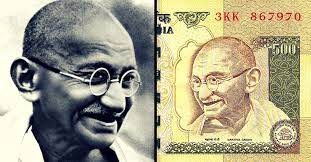Throughout history, the lens of prominent photographers captured Mahatma Gandhi, but perhaps the most iconic image of him is the one adorning Indian currency notes. As the Father of the Nation, it might seem natural for him to be featured on India’s national currency, but this honor was conferred upon him several decades after India gained independence in 1947. In 1996, Gandhi’s image became a permanent fixture on all denominations of legal banknotes issued by the Reserve Bank of India (RBI), the nation’s central bank entrusted with overseeing India’s banking system. As we approach Gandhi’s birth anniversary, we delve into the origins of this portrait, the symbol it replaced, and the suggestions that have emerged for featuring other iconic figures on Indian banknotes.
The Origins of Gandhi’s Image on Indian Currency
The portrait of Gandhi on Indian banknotes is not a caricature; rather, it is a cut-out of a photograph taken in 1946, where he stands alongside British politician Lord Frederick William Pethick-Lawrence. This particular photograph was chosen because it captured Gandhi with a suitable smile, which was then mirrored to create the iconic portrait. Interestingly, the identities of the photographer behind this image and the person who selected it remain shrouded in mystery.
The responsibility of designing Indian rupee notes lies with the RBI’s Department of Currency Management, which must obtain approval for its designs from the central bank and the Union government. According to Section 25 of the RBI Act, 1934, the central government has the authority to approve the “design, form, and material of banknotes” based on recommendations made by the central board.
When Gandhi First Appeared on INR Notes
Gandhi’s first appearance on Indian currency occurred in 1969 when a special series was issued to commemorate his 100th birth anniversary. These notes, bearing the signature of RBI Governor LK Jha, depicted Gandhi against the backdrop of the Sevagram Ashram.
In October 1987, a series of Rs 500 currency notes featuring Gandhi was introduced.
The Banknotes of Independent India
Following India’s declaration of independence on August 15, 1947, the RBI initially continued to issue notes featuring King George VI from the colonial period. However, this situation changed in 1949 when the government of India introduced a new design for the 1-rupee note. In this new design, King George was replaced with a symbol of the Lion Capital of Ashoka Pillar at Sarnath.
 The RBI museum website shares insights from that era, noting that there were deliberations about selecting symbols for independent India. Initially, the idea was to replace the King’s portrait with that of Mahatma Gandhi. Design proposals were even prepared for this purpose. However, the consensus eventually shifted towards choosing the Lion Capital at Sarnath in place of Gandhi’s portrait. The new banknote designs largely followed the earlier patterns.
The RBI museum website shares insights from that era, noting that there were deliberations about selecting symbols for independent India. Initially, the idea was to replace the King’s portrait with that of Mahatma Gandhi. Design proposals were even prepared for this purpose. However, the consensus eventually shifted towards choosing the Lion Capital at Sarnath in place of Gandhi’s portrait. The new banknote designs largely followed the earlier patterns.
Consequently, in 1950, the first Republic of India banknotes were issued in denominations of Rs 2, 5, 10, and 100, all bearing the Lion Capital watermark. Over the years, higher denomination legal tenders were introduced, with motifs on the back of the notes evolving to reflect various aspects of new India, from wildlife motifs such as tigers and sambar deer to depictions of agricultural activities like farming and tea leaf plucking in the 1970s. The 1980s saw an emphasis on symbols of scientific and technological advancements as well as Indian art forms, with the Aryabhatta satellite, farm mechanization, and the Konark Wheel featuring on various denominations.
Gandhi’s Portrait Becomes a Permanent Feature
By the 1990s, the RBI recognized the need to enhance the security features of currency notes due to advancements in reprographic techniques such as digital printing, scanning, photography, and xerography. It was believed that inanimate objects would be easier to forge compared to a human face. Consequently, Gandhi was chosen as the new face of Indian currency due to his universal appeal. In 1996, the RBI introduced the ‘Mahatma Gandhi Series’ to replace the former Ashoka Pillar banknotes. This series also incorporated several security features, including a windowed security thread, latent image, and intaglio features designed for the visually impaired.
In 2016, the ‘Mahatma Gandhi New Series’ of banknotes was announced by the RBI, retaining Gandhi’s portrait while adding the Swachh Bharat Abhiyan logo and additional security features on the reverse side.
Demands for Inclusion of Others on Banknotes
In recent years, there have been calls to feature figures other than Gandhi on Indian currency notes. In October 2022, Delhi Chief Minister Arvind Kejriwal appealed to the Prime Minister and the Union government to include the images of Lord Ganesha and goddess Lakshmi on currency notes.
Similarly, in 2014, there were suggestions to include Nobel Laureate Rabindranath Tagore and former President APJ Abdul Kalam on currency notes. However, then Finance Minister Arun Jaitley, addressing the Lok Sabha, revealed that the RBI had rejected these proposals in favor of retaining Gandhi’s portrait. He stated, “The Committee decided that no other personality could better represent the ethos of India than Mahatma Gandhi.”
Furthermore, then RBI Governor Raghuram Rajan emphasized that while India had many great personalities, Gandhi stood out above all others, and other choices could potentially be controversial.
The journey of Mahatma Gandhi’s image on Indian currency is a reflection of India’s evolving identity and the significance attributed to its national icons. While there have been calls to diversify the figures featured on banknotes, Gandhi’s enduring presence continues to symbolize the ethos of India.
